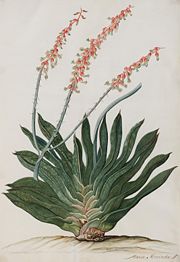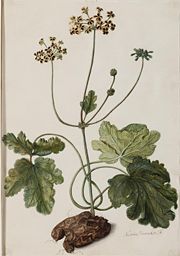
Maria Moninckx
Encyclopedia


Hortus Medicus
In 1682 Joan Huydecoper IIJoan Huydecoper II
Joan Huydecoper van Maarsseveen II was the eldest son of burgomaster Joan Huydecoper van Maarsseveen I and the brother-in-law of the collector Jan J. Hinlopen and the sheriff Jacob Boreel. He was mayor of Amsterdam for 13 terms between 1673 and 1693...
and Jan Commelin
Jan Commelin
Jan Commelin , also known as Jan Commelijn or Johannes Commelinus, was the son of Isaac Commelin a historian; his brother Casparus was a bookseller and newspaper publisher. Jan a botanist became a professor of botany when many plants were imported from the Cape and Ceylon and a new system had to be...
took the initiative in establishing a new Hortus Medicus in Amsterdam. It differed from the herb garden at the Binnengasthuis insofar as it also grew ornamental plants and would function as a Hortus Botanicus. Huydecoper was mayor of Amsterdam and had great influence with the Dutch East India Company
Dutch East India Company
The Dutch East India Company was a chartered company established in 1602, when the States-General of the Netherlands granted it a 21-year monopoly to carry out colonial activities in Asia...
, while Commelin was a merchant in herbs and pharmaceuticals. Both men were well-known as enthusiastic and knowledgeable gardeners. Because of theircontacts in the business world and their practical horticultural experience, they received a constant stream of plants, seeds, bulbs and cuttings to be cultivated far from their original habitat.
This led to the creation of one of the richest plant collections in Europe. Plants of commercial value, also potherbs, edible crop plants and medicinal plants, were propagated in the garden for planting elsewhere. An example of this was the coffee
Coffee
Coffee is a brewed beverage with a dark,init brooo acidic flavor prepared from the roasted seeds of the coffee plant, colloquially called coffee beans. The beans are found in coffee cherries, which grow on trees cultivated in over 70 countries, primarily in equatorial Latin America, Southeast Asia,...
plant, which oddly, was not illustrated in the Moninckx Atlas, but became the backbone of the Brazilian coffee industry. In addition many ornamental plants, especially strange and exotic plants, were cultivated. These plants were grown for pure interest, curiosity value and often for further research.
Moninckx Atlas
Between 1686 and 1709, Huydecoper and Commelin commissioned 420 large parchment aquarels of plants growing in the Amsterdam garden. The garden did not have a herbariumHerbarium
In botany, a herbarium – sometimes known by the Anglicized term herbar – is a collection of preserved plant specimens. These specimens may be whole plants or plant parts: these will usually be in a dried form, mounted on a sheet, but depending upon the material may also be kept in...
, and a pictorial record in the form of paintings, would create something of permanent value.
Four very accomplished artists were employed to tackle this extensive project. The lion's share of work was done by Jan Moninckx: 273 sheets bear his signature. Maria Moninckx, his daughter, produced 101 paintings. The other artists were Alida Withoos
Alida Withoos
Alida Withoos was a Dutch botanical artist and painter. She was the daughter of the painter Matthias Withoos.-Life:...
(13 aquarels) and Johanna Helena Herolt-Graff (daughter of Maria Sibylla Merian
Maria Sibylla Merian
Maria Sibylla Merian was a naturalist and scientific illustrator who studied plants and insects and made detailed paintings about them...
) with 2 sheets; 31 aquarels were unsigned. The heraldic arms of Huydecoper and Commelin, painted by Jan Moninckx, were used to decorate volume 1 of the Atlas. In 1749 there was an attempt to expand the collection. This 9th volume consisted of a mere five aquarels, one by Dorothea Storm-Kreps and four by Jan Matthias Cock. The illustrated plants in the first five volumes and part of the sixth, had their names printed in both Latin and Dutch. The Latin names in bold Roman type, and the Dutch names in elegant Gothic calligraphy.
This monumental work is still of great taxonomic, historic, and artistic interest. The aquarels have served as the basis for engravings in the Horti Medici Amstelodamensis rariorum plantarum historia, part 1, by Jan Commelin, appearing in 1697 and part 2, by his cousin Caspar Commelin, in 1701. The famed botanist Carolus Linnaeus
Carolus Linnaeus
Carl Linnaeus , also known after his ennoblement as , was a Swedish botanist, physician, and zoologist, who laid the foundations for the modern scheme of binomial nomenclature. He is known as the father of modern taxonomy, and is also considered one of the fathers of modern ecology...
based the taxonomy for his Species plantarum of 1753 on no fewer than 259 species from the Moninckx Atlas. A recent scanning of the complete work has made the plates and text available on the University of Amsterdam website.
Moninckx family
The Moninckx family had a long tradition of being painters and were researched in a book titled De Schildersfamilie Moninckx, published by Abraham Bredius in 1889. Well-known was Gijsbert Moninckx, a member of the Guild of St Lucas in The HagueThe Hague
The Hague is the capital city of the province of South Holland in the Netherlands. With a population of 500,000 inhabitants , it is the third largest city of the Netherlands, after Amsterdam and Rotterdam...
in 1605. Bredius' book confuses Maria Moninckx with Machteld Moninckx, the widow of Paulus Dinant.
Maria's father was Jan Moninckx
Jan Moninckx
Jan Moninckx , was a Dutch botanical artist and painter, best known for the colour plates he and his daughter, Maria Moninckx, created and which make up the nine-volume Moninckx Atlas...
, her collaborator on the Moninckx Atlas, and her mother was Ariaentje Pieters.
On 18 April 1723 Maria signed a betrothal register in Amsterdam, avowing her intention to marry Martinus de la Ruel. Maria's age was given as 47 years and her place of residence as The Hague, while Martinus was 46 years old and from Amsterdam. Maria's signature in the betrothal register corresponds with her signature on the aquarels of the Moninckx Atlas.

